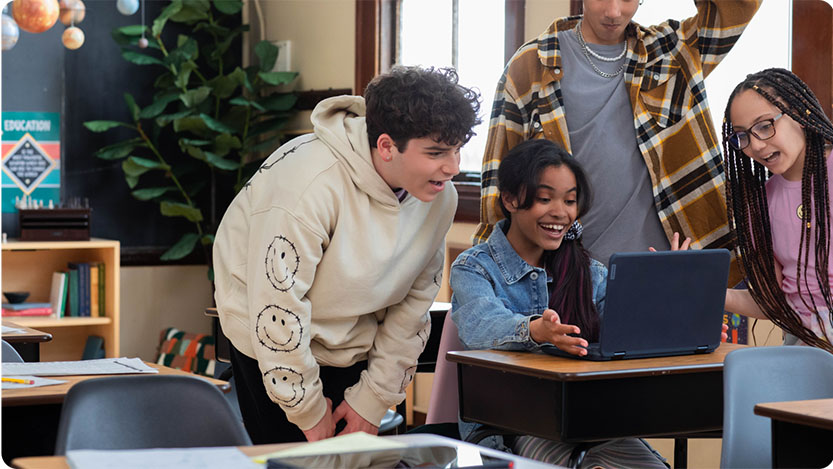Blog post
From generative AI to Gen Z How brands can win the next digital shopping revolution

The new generation of shoppers has arrived.
Gen Z is hitting life’s biggest buying moments, and generative AI is positioned to enrich their consumer journeys as a personalized advisor for finding information, comparing options, and securing the sale. If you’re not part of that conversation, you’re not in the cart.
It’s time to reframe how we think about Gen Z. The oldest members of this generation are 28 years old. They’re part of the workforce, buying homes, raising families, and driving household purchasing decisions. And their total spending power is accelerating fast. eMarketer notes that Gen Z’s global spending is expected to leap from $2.7 trillion in 2024 to $12.6 trillion by 2030, making them an attractive audience for brands.
Over 30% of Copilot mobile app users are part of Gen Z, for example.1 They’re reshaping digital shopping and creating new opportunities for advertisers to connect. Here’s what you need to know to keep pace.
Why Gen Z's AI habits are critical for advertisers to understand
Gen Z’s device of choice is the smartphone, and that's great news for advertisers. Overall, they spend more time in mobile apps than any other generation.2
New research from Microsoft and Suzy found that 77% of U.S. shoppers save items in wish lists or carts before purchasing, especially Gen Z.3 Our internal data expands on this, revealing that Gen Z shoppers are most likely to convert within 1–7 days, compared to the average Microsoft customer journey of around 2 weeks.4 They also tend to make 2–7 searches before purchasing, showing thorough consideration of product options.5
Despite this thorough journey, Gen Z typically only engages with 1–2 ads before purchasing.6 What’s more, unlike other groups, Gen Z has already built awareness of popular brands through organic research, shaping a brand to nonbrand ad ratio of 53% vs. 47%—the only generation segment where brand ads outperform nonbrand ones.7 This signals that Gen Z is highly selective about ad content relevance and relies on their own discovery journey before making a final purchase. In other words, relevance beats repetition.
To effectively engage Gen Z, advertisers should combine brand ads with exposure-driven, experience-focused native formats. This builds early-phase awareness while ensuring brand ads drive conversions later in the funnel.
While Gen Z is digitally native, they also still value physical retail. eMarketer notes that they prefer a blend of online and in-store shopping, reinforcing the need for an omnichannel strategy. Microsoft’s ecosystem supports this approach: On mobile, Bing and Copilot over-index with Gen Z. With 96% of weekly players engaging with at least one of the major gaming platforms—mobile, console, or PC—advertisers have a clear opportunity to reach Gen Z through premium ad formats delivered via in-game inventory from Activision Blizzard, Xbox, and Microsoft Casual Games.8
Takeaway: Gen Z does in-depth research, but their digital fluency makes them easier to engage if your message is meaningful from the start.
What Gen Z expects from ads and shopping experiences
When developing campaigns that resonate, it’s important to understand exactly what Gen Z wants from ads and the shopping experience.
Microsoft research shows that this generation has strong loyalty toward brands: 61% of shoppers age 18 to 24 converted from pure brand ads or mixed brand ads in a campaign, compared to just 56% for shoppers age 35 to 49.9 Strategically, when you’re trying to reach Gen Z buyers, upper funnel campaigns may be effective.
Dynamic and visual content formats capture and hold Gen Z’s attention. Social media posts, product videos, and gaming content are the most engaging. At the same time, Gen Z relies on user reviews, product comparisons, and testimonials to help drive decisions. They're also more likely than older generations to find influencer and social media content helpful.10
So brands that discover creative ways to deliver these formats can see results and connect with highly desirable audiences. For example, Copilot users show a 9% higher click-through rate for Responsive Search ads compared to users who don't interact with Copilot.11
Takeaway: Reaching Gen Z with ads requires relevance and resonance. Generative AI-powered personalization and multi-format campaigns can help deliver on that potential.
Optimizing for generative AI-native discovery
Advertisers that optimize their campaigns for generative AI-native discovery are well-positioned to connect with engaged Gen Z buyers. Strategies that can help performance include:
- Adopt a multi-touchpoint ad strategy. For example, Copilot users frequently start on search, email, or video on demand, move into Copilot for conversational exploration, and then return to search, email, news, or e-commerce to complete a purchase.12 A cohesive ad strategy that leverages search and conversational AI can support conversions.
- Prepare for conversational queries. Voice-driven shopping and question-based AI searches are on the rise, and conversational AI is designed for this future. Advertisers will stand out by moving beyond keyword-heavy approaches to optimize content for natural, conversational phrasing.
- Invest in personalization. Generative AI can deeply infer user search intent thanks to natural language processes. Instead of targeting users by demographic, predictive targeting helps identify the right buyers through search intent. If a user shows in-market behavior, they’ll be automatically added to target lists.
- Use frequency capping. Manage the frequency of your ads with repeat buyers. High repetition can irritate Gen Z audiences.13 The right controls balance exposure while avoiding oversaturation.
- Ensure authenticity. Tools like clear brand guidelines and human oversight will keep your ads feeling genuine and consistent across touchpoints, achieving scale with generative AI while preserving authenticity.
Takeaway: Gen Z may be more AI-proficient, but effective ad campaigns will recognize their need to connect with genuine stories delivered at the right time and place.
Microsoft Advertising makes it easier to connect with Gen Z audiences
As an important market force, Gen Z's significance will only continue to grow. Their mobile, voice-first, and AI-powered behaviors are reshaping the future of effective advertising. From gaming to news to productivity solutions, Microsoft’s ecosystem touches all the spaces Gen Z relies on to shop, play, research, and decide.
Want to learn more about reaching Gen Z? Download our latest insights...
- Find out how Gen Z interacts with chatbots and agents in A marketer's guide to chatbots and agents: From generative AI to ROI.
- Explore interactive advertising ideas that’ll resonate with Gen Z in Decoding the modern consumer: Solving the digital advertising puzzle when everything is shoppable.
Just getting started with Microsoft Advertising? Request a free consultation with one of our experts today.
[1] Microsoft First Party Data | Oct 2024 to Jan 2025 | Global
[2] Sensor Tower, Oct 2024 to Feb 2025 | comScore, Oct 2024. The full Gen Z population is between 2012 and 1996, only 18+ is included in this analysis for data compliance.
[3] Microsoft & Suzy Inc, Digital Shopping Journey: US, Aus, UK, Dec 2024
[4] Microsoft Internal Data, US Market of 191K tracked customer conversion journeys, Jan 2025 – Mar 2025
[5] Microsoft Internal Data, US Market of 191K tracked customer conversion journeys, Jan 2025 – Mar 2025
[6] Microsoft Internal Data, US Market of 191K tracked customer conversion journeys, Jan 2025 – Mar 2025
[7] Microsoft Internal Data, US Market of 191K tracked customer conversion journeys, Jan 2025 – Mar 2025
[8] Activision Blizzard Media Simultaneous Media Usage Study via Toluna, Oct - Nov 2024 (Base: US Adults 18+)
[9] Microsoft Internal Data, US Market of 191K tracked customer conversion journeys, Jan 2025 – Mar 2025
[10] Microsoft & Suzy Inc, Digital Shopping Journey: US, Aus, UK, Dec 2024
[11] Microsoft First-Party Data, Dec 2024–Jan 2025
[12] Microsoft 1P Data | Dec 21, 2024 to Dec 31, 2024 | US only | Edge users
[13] Microsoft & Suzy Inc, Digital Shopping Journey: US, Aus, UK, Dec 2024
Your input makes us better
Take our quick 3-minute survey and help us transform your website experience.





